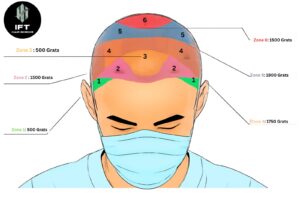If you’re considering a hair transplant in India, one of the first questions you’ll likely have is about the cost. Hair restoration procedures have gained immense popularity in recent years, not only for the high-quality results they deliver but also due to the affordability compared to other countries. But how much does a hair transplant actually cost in India?
Factors Affecting the Hair Transplant Price in India
The hair transplant price in India can vary significantly depending on several factors. These include the technique used, the number of grafts required, the expertise of the surgeon, and the clinic’s reputation. In general, the hair transplant charges in India range from ₹50,000 to ₹2,00,000, depending on these variables.
Understanding these factors can help you better estimate the cost and choose the best option for your needs. Making the right choice can lead to better results and ensure a procedure that fits your budget.
Key Factors Influencing the Hair Plantation Cost in India
Number of Grafts: The number of hair follicles you need to be transplanted will directly impact the hair grafting cost in India. More grafts mean a higher cost. On average, clinics charge per graft, and the cost can range from ₹30 to ₹100 per graft.
Technique Used: There are two main types of hair transplant techniques—Follicular Unit Extraction (FUE) and Interlocking FUE Technique (IFT). Each method has its own advantages and price point. Hair plantation price in India typically depends on the technique used.
Surgeon’s Expertise: Experienced surgeons tend to charge higher fees, but their skill and knowledge significantly impact the quality of the procedure and your results. It’s essential to choose a surgeon who specializes in hairline transplants for the best outcomes.
Clinic Location: Cities like Mumbai, Delhi, Bangalore, and Pune are known for their good clinics. However, the rate of hair transplant in India may differ based on the location. Major metropolitan areas usually have higher prices due to the presence of more advanced facilities.
Additional Costs to Consider
Apart from the procedure itself, there are additional costs to factor into your budget when planning for a hair transplant in India.
-
Consultation Fees: Many clinics charge for initial consultations, though some may offer a free consultation. Make sure to clarify this upfront.
-
Post-Operative Care: Post-surgery medications, shampoos, and follow-up visits can add an extra ₹10,000 to ₹20,000 to your overall hair transplant fees in India.
-
Travel and Accommodation: If you’re traveling to a different city for the procedure, don’t forget to factor in travel and accommodation costs.
-
Maintenance: Some patients may require additional treatments after their transplant to maintain or enhance results. These can include PRP therapy or laser hair treatments, adding more to the hair transplant fees in India.
Number of grafts required-

The extent of hair loss and the number of grafts required significantly impact the total cost of the procedure. Clinics in India typically charge per graft, which ranges from ₹20 to ₹100 per graft. The number of grafts required depends on the size of the balding area and the desired density of hair.
- Mild hair loss: 1,000 to 1,500 grafts may be required, which can cost between ₹20,000 to ₹1,50,000. This is usually suitable for patients with early-stage hair loss or those looking to fill in smaller areas.
- Moderate hair loss: 1,500 to 3,000 grafts may be required, which can cost between ₹30,000 to ₹3,00,000. This category includes patients with more noticeable thinning or bald spots who require significant coverage.
- Severe hair loss: More than 3,000 grafts may be needed, which can cost anywhere from ₹60,000 to ₹6,00,000 or more. Patients with very severe baldness or those who want a fuller look may need a higher number of grafts, which increases the cost.
Surgeon’s Expertise and Reputation-
The experience and reputation of the surgeon play a crucial role in the pricing. Highly experienced and renowned surgeons may charge a premium for their services. It’s important to choose a qualified and experienced surgeon to ensure the best results. Surgeons with a strong track record, numerous successful cases, and positive patient testimonials often command higher fees.
However, investing in a skilled surgeon can significantly impact the success and satisfaction of the procedure. Patients should thoroughly research and verify the credentials, training, and experience of the surgeon before making a decision. A reputable surgeon is likely to offer better outcomes and minimize the risk of complications.
Clinic Facilities and Technology-
The quality of the clinic’s facilities and the technology used can influence the cost. Clinics equipped with state-of-the-art technology and adhering to international standards of hygiene and care may charge higher fees. Advanced equipment and modern techniques can enhance the precision, safety, and effectiveness of the hair transplant procedure.
Clinics that invest in continuous training for their staff and keep up with the latest advancements in hair transplant technology often provide better results. Patients should consider the overall environment, cleanliness, and professionalism of the clinic when evaluating costs. High-quality facilities can contribute to a more comfortable experience and better post-operative care.
Location of the Clinic-
The geographical location of the clinic in India can also affect the cost. Clinics in metropolitan cities like Mumbai, Delhi, and Bangalore tend to charge more due to higher operational costs compared to clinics in smaller cities. The cost of living, overhead expenses, and demand for hair transplant services in these cities contribute to the higher prices.
For example, clinics in major cities often have state-of-the-art facilities and experienced surgeons who cater to a larger number of patients, both domestic and international. On the other hand, hair transplant clinics in Jaipur benefit from a lower cost of living and more competitive pricing. These clinics often provide equally qualified surgeons and high-quality services, making them an attractive option for those seeking affordable hair restoration solutions without compromising on quality.
Patients might find that clinics in smaller cities or towns, such as Jaipur, offer highly skilled professionals and satisfactory results at a fraction of the cost compared to their counterparts in larger cities.
Cost Comparison by Indian Cities:
| City | Price Range (INR) | Key Features |
|---|---|---|
| Mumbai | ₹50,000 – ₹90,000 | Advanced medical infrastructure, experienced surgeons, comprehensive packages. |
| Delhi | ₹40,000 – ₹120,000 | High competition among clinics, reputed centers, excellent connectivity. |
| Bangalore | ₹45,000 – ₹85,000 | Modern clinics, skilled professionals. |
| Hyderabad | ₹30,000 – ₹75,000 | A growing number of certified professionals. |
| Jaipur | ₹25,000 – ₹65,000 | Budget-friendly, renowned for skilled surgeons at competitive rates, traditional hospitality combined with modern medical expertise. Jaipur’s low cost of living contributes to the affordability of medical procedures, making it ideal for budget-conscious patients. |
The cost can vary significantly depending on several factors, including the city, the clinic’s reputation, the type of procedure, and the number of grafts required. While the prices listed above serve as a general guide, it’s important to note that costs may vary based on the complexity of the procedure and the clinic’s location.
Why Choose India for Your Hair Transplant?
India has emerged as a hub for affordable, high-quality hair transplants due to the following reasons:
Affordability: The cost of hair restoration procedures in India is significantly lower compared to Western countries. Whether you’re looking for a hair transplant in Jaipur or a hair transplant in Jodhpur the price is reasonable without compromising on quality.
Experienced Surgeons: India boasts a large number of highly skilled hair transplant surgeons who have trained internationally and offer world-class results.
High Success Rates: Clinics in India are known for their high success rates, with advanced techniques like FUE and IFT ensuring long-lasting and natural results.
Medical Tourism: India is a popular destination for medical tourists, offering excellent healthcare facilities and affordable treatments.
Tips to Choose the Right Clinic for Hair Transplant in India
Do Your Research: Take time to research clinics and read patient reviews. Look for clinics that specialize in hair grafting or hair plantation specifically.
Ask About the Surgeon’s Experience: Make sure the surgeon has experience with hairline transplants and has a proven track record of successful surgeries.
Inquire About the Cost Structure: Get a detailed breakdown of the hair transplant charges in India, including any hidden fees. Ensure that consultation, post-op care, and any other services are covered.
Check for Accreditation: Look for clinics accredited by health organizations to ensure you receive quality care and safe procedures.
Financing Options:
Many clinics in India offer financing options to help patients manage the cost of hair transplant. These options may include:
- Payment Plans: Spread the cost over several months or years. Flexible payment plans can make the procedure more affordable by breaking down the total cost into manageable installments.
- Medical Loans: Specialized loans for medical procedures. Some financial institutions offer loans specifically for medical treatments, including hair transplants. These loans often come with favorable interest rates and repayment terms.
- Credit Cards: Some patients use credit cards to cover the cost, although this may result in high-interest payments. Using a credit card can be a convenient option, but it’s important to consider the interest rates and repayment terms to avoid long-term financial strain.
Conclusion:
The rate of hair transplant in India offers significant value for those seeking hair restoration treatments. With skilled surgeons, modern techniques, and affordable pricing, India stands out as an ideal destination for a hair transplant. Whether you’re considering a hair implant or a hair plant, understanding the costs, along with the factors affecting the pricing, will help you make an informed decision.
If you’re ready to start your journey towards hair restoration, make sure to schedule a consultation with a reputed clinic and get a personalized estimate based on your needs and goals.
FAQ
What are the different hair transplant techniques, and how do their costs compare?
There are several hair transplant techniques, each with its unique process and cost:
FUE (Follicular Unit Extraction): FUE is generally more expensive than FUT, but it offers a less invasive experience and faster recovery.
FUT (Follicular Unit Transplantation): Involves removing a strip of skin from the donor area, typically making it less expensive than FUE.
DHI (Direct Hair Implantation): A more advanced technique, often priced higher than FUE and FUT
Biofibre: A non-surgical option, with costs depending on the number of fibers implanted, offering a different approach for those seeking alternatives to surgical procedures.
What are the estimated costs of different hair transplant techniques ?
The estimated costs for hair transplant techniques vary based on the number of grafts and the technique used:
Per Graft: ₹20-₹120 or more.
1000 Grafts: Starting from ₹25,000.
3000-4000 Grafts: ₹80,000 to ₹2,00,000 or more, depending on the technique and clinic.
How much do 3,000 hair grafts cost in India?
The cost of a 3,000-graft hair transplant in India typically ranges from ₹70,000 to ₹3,60,000, depending on factors such as the clinic’s location, the surgeon’s expertise, and the chosen technique.
Is hair transplant 100%?
A hair transplant has an average success rate of 97%, with around 90-95% of patients happy with the results. Most people seek hair loss surgery between ages 30 and 39. While results are generally great, it’s not always 100% guaranteed, as factors like the surgeon’s skill and the patient’s hair type can affect the outcome.






